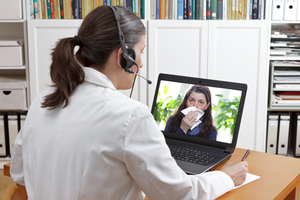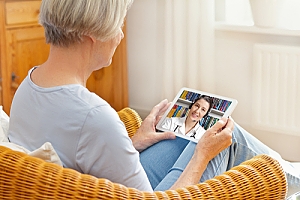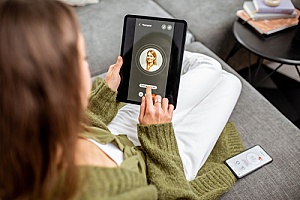The COVID–19 pandemic has brought telemedicine to the forefront of the public’s attention. Telemedicine seems like a wonderful new way to deliver medical advice, but in fact, telemedicine has been in use for decades. It has been used successfully to help patients located in remote settings who are unable to access in-person medical care, such as soldiers in combat settings, patients in rural locations, and patients who need advice from specialists located in another part of the world.
Benefits Of Telemedicine
Telemedicine does not replace the need for in-person visits to a health care provider for emergency treatments. Although telemedicine is primarily a supplement to traditional in-person visits, it is well-suited for the overall management of a patient’s health and offers many benefits. Here are just a few:
Virtual Consultations & Examinations
 Through your computer, you can connect to health care providers who are located anywhere in the world. From your own home, office, or anywhere you have access to the internet, you will be able to see, hear, and talk to a health care professional. They can conduct a visual examination of you almost as if you are physically in their office. If you need a physical examination or medical test, you can be referred based on the virtual examination.
Through your computer, you can connect to health care providers who are located anywhere in the world. From your own home, office, or anywhere you have access to the internet, you will be able to see, hear, and talk to a health care professional. They can conduct a visual examination of you almost as if you are physically in their office. If you need a physical examination or medical test, you can be referred based on the virtual examination.
It is an ideal way for you and your healthcare provider to monitor how well you are managing any chronic conditions, to have a prescription refilled, and to monitor the progress of your recovery from a medical treatment, or an illness or an injury.
Added Convenience
Not every consultation with your health care provider requires an in-person visit. Telemedicine provides a convenient solution to avoid interrupting your schedule to travel to and wait in the doctor’s office for a minor problem. The health care provider gets to communicate with the patient, and the patient can avoid taking time out of a busy schedule to do it.
For patients with limited mobility, expectant mothers, or anyone caring for children in the home, this is an invaluable benefit. Those patients can keep their doctor’s appointments without having to deal with challenging transportation issues or finding a babysitter in order to keep their appointments.
What Happens During a Telemedicine Appointment?
Your health care provider will use a secure video-conferencing application developed specifically for health care providers. Once you schedule the appointment, your health care provider will send you a secure, HIPAA-compliant link to access the appointment.
Appear In Front Of The Healthcare Provider
 Once you access the virtual appointment through the link provided, you will find a telemedicine appointment is very similar to any other online meeting. You, as the patient, will sit in front of your computer or online camera. Your own image will appear on the screen along with the image of your healthcare provider(s). If you want to have a friend or family member with you during the appointment, you are free to do so just like you would in an in-person visit.
Once you access the virtual appointment through the link provided, you will find a telemedicine appointment is very similar to any other online meeting. You, as the patient, will sit in front of your computer or online camera. Your own image will appear on the screen along with the image of your healthcare provider(s). If you want to have a friend or family member with you during the appointment, you are free to do so just like you would in an in-person visit.
Questions & Data Collection
Your health care provider team will initiate the meeting by asking you questions about your health issues and discussing them with you in detail. If you are a patient who uses mobile medical equipment, the health care provider can monitor and collect data on your blood pressure, blood sugar levels, heartbeat, and other vital health signs.
Reviewing & Submitting Medications
For a patient who needs a prescription or a prescription refill, such as a birth control prescription, your health care provider can conduct a virtual visit and call in the prescription to your preferred pharmacy. An in-person visit is not necessarily required for this service.
Telemedicine In Reproductive & Women’s Health
In women’s health, telemedicine can enhance the delivery of health care in a wide range of services, including contraception, menopausal management, and treating sexually transmitted diseases.
Pregnancy & Prenatal Care
 For pregnancy and prenatal care, pregnant women can be monitored from home using telemedicine. Their health care provider can keep up with the mother’s health and the progress of the pregnancy, and through mobile medical equipment can monitor blood pressure, fetal heart rate, fundal height, blood sugar, and other vital signs.
For pregnancy and prenatal care, pregnant women can be monitored from home using telemedicine. Their health care provider can keep up with the mother’s health and the progress of the pregnancy, and through mobile medical equipment can monitor blood pressure, fetal heart rate, fundal height, blood sugar, and other vital signs.
The convenience of using telemedicine can make it easier for pregnant mothers to keep up with regular appointments, identify potential issues, and manage developing health conditions before they become serious.
Abnormal Situations
In abnormal situations, telemedicine can facilitate better outcomes. For example, telemedicine enables the health care provider to monitor blood glucose in diabetic pregnancies. The results of using telemedicine in these cases have shown improved glycemic control in them, with better fetal and maternal outcomes.
Reach Out To Raleigh Gynecology & Wellness
Talk to the women’s health experts at Raleigh Gynecology & Wellness about the telemedicine services we offer. Our helpful practice administrators will be happy to describe all the services we offer, and particularly how telemedicine can help save you time and money while improving your health management overall. Contact Raleigh Gynecology for more information by calling 919.636.6670 or schedule an appointment online.

 With the COVID-19 virus spreading around the world, people are hearing more about getting medical care the 21st century way: Telemedicine. COVID-19 is bringing telemedicine to the forefront of healthcare, and the benefits it offers to patients and health care providers will likely be with us after the virus has run its course. Here is some basic information to help you understand what telemedicine is.
With the COVID-19 virus spreading around the world, people are hearing more about getting medical care the 21st century way: Telemedicine. COVID-19 is bringing telemedicine to the forefront of healthcare, and the benefits it offers to patients and health care providers will likely be with us after the virus has run its course. Here is some basic information to help you understand what telemedicine is. The term, telehealth is a term to broadly describe any electronic and telecommunications technologies and services used to provide care and services at-a-distance. It covers a broader scope of remote health care services than telemedicine. According to the World Health Organization, telehealth includes, “surveillance, health promotion, and public health functions.”
The term, telehealth is a term to broadly describe any electronic and telecommunications technologies and services used to provide care and services at-a-distance. It covers a broader scope of remote health care services than telemedicine. According to the World Health Organization, telehealth includes, “surveillance, health promotion, and public health functions.” Not every situation requires an in-person visit. Used in appropriate cases, telemedicine is much more efficient than traditional medical visits. It allows doctors to pre-screen a patient to determine if an in-person visit is needed. Telemedicine is particularly efficient for patient follow-up visits, management of chronic conditions, medication management, and in some cases for specialist consultations. Telemedicine makes it possible for you and your primary care physician to involve specialists who may be located in another part of the world. You can now consult with the best medical specialists available no matter where you live.
Not every situation requires an in-person visit. Used in appropriate cases, telemedicine is much more efficient than traditional medical visits. It allows doctors to pre-screen a patient to determine if an in-person visit is needed. Telemedicine is particularly efficient for patient follow-up visits, management of chronic conditions, medication management, and in some cases for specialist consultations. Telemedicine makes it possible for you and your primary care physician to involve specialists who may be located in another part of the world. You can now consult with the best medical specialists available no matter where you live. During an epidemic outbreak like COVID-19, patients can practice self-distancing even while the doctor examines them for illness. Even though the doctor does not see the patient in person, the doctor can get a lot of information about the patient’s health from a simple observation of the patient. The doctor can observe the patient’s pallor, or can recognize symptoms of illness, such as labored breathing, coughing, excessive perspiration, or confusion when speaking while, at no point has the patient or the medical staff been exposed to risk of contamination.
During an epidemic outbreak like COVID-19, patients can practice self-distancing even while the doctor examines them for illness. Even though the doctor does not see the patient in person, the doctor can get a lot of information about the patient’s health from a simple observation of the patient. The doctor can observe the patient’s pallor, or can recognize symptoms of illness, such as labored breathing, coughing, excessive perspiration, or confusion when speaking while, at no point has the patient or the medical staff been exposed to risk of contamination.